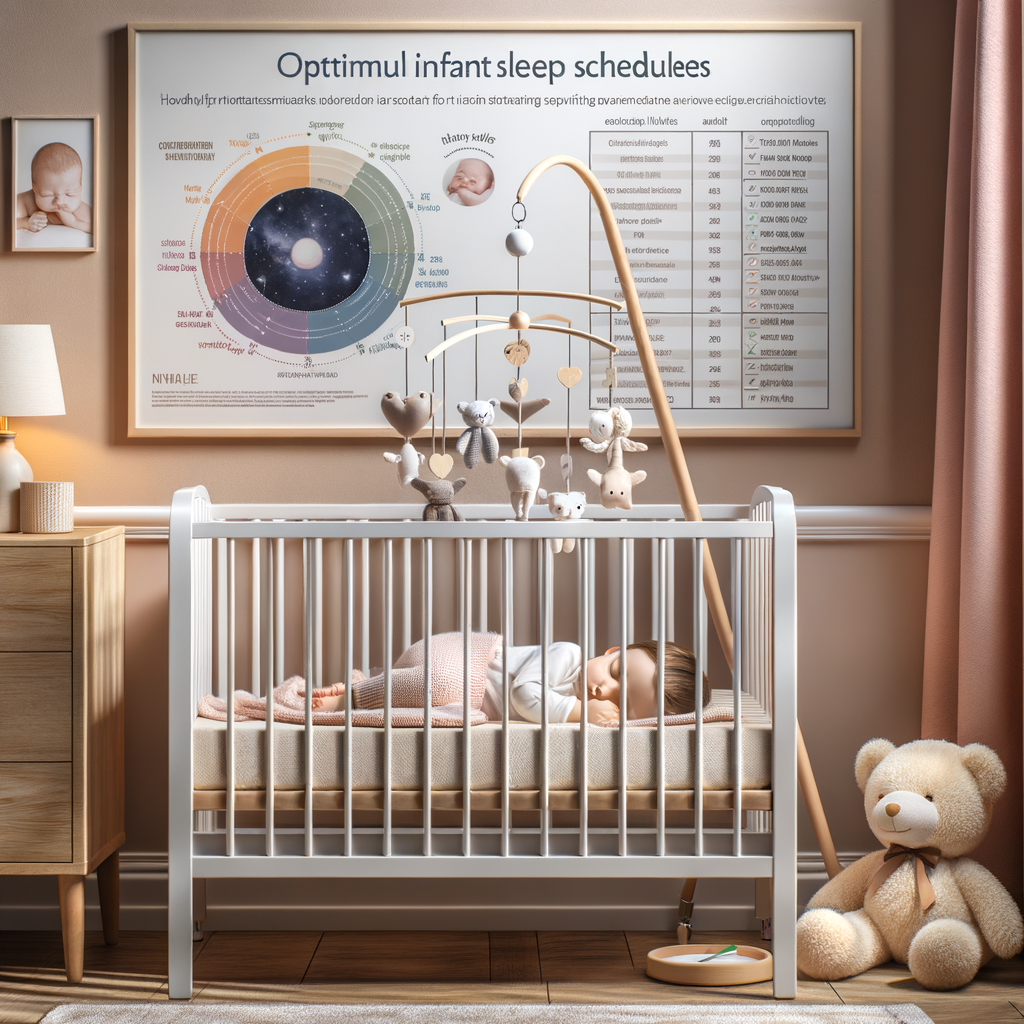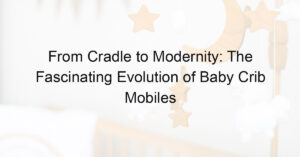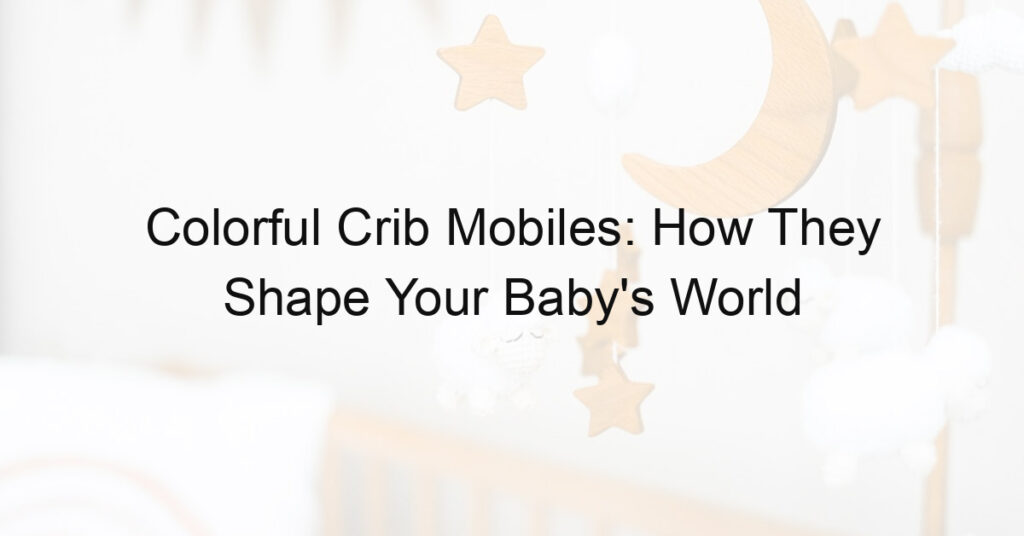
Introduction to Sleep Training and Crib Mobiles
Welcome to our comprehensive guide on sleep training and the role of crib mobiles. This guide aims to provide you with a clear understanding of these concepts and their importance in establishing a healthy sleep schedule for your baby.
Sleep training is a method used by parents to help their babies learn to fall asleep on their own. It involves establishing a routine and teaching your baby to self-soothe, which can lead to longer, more restful sleep for both you and your baby. Sleep training is not a one-size-fits-all approach; it requires patience, consistency, and a method that works best for your family.
-
- The role of crib mobiles in sleep training
Crib mobiles are more than just decorative items for your baby’s nursery. They play a significant role in sleep training. Crib mobiles can provide visual and auditory stimulation that can soothe your baby to sleep. They can also serve as a signal for your baby that it’s time to sleep, especially when used consistently as part of your baby’s bedtime routine.
-
- Importance of a baby sleep schedule
Establishing a sleep schedule for your baby is crucial for their growth and development. Consistent sleep and wake times can help regulate your baby’s internal clock, leading to better sleep quality. A predictable sleep schedule can also make your baby feel secure and help them learn the difference between day and night, which is essential for their sleep training journey.
As we delve deeper into this guide, we will explore different sleep training techniques, the science behind infant sleep patterns, and how crib mobiles can aid in baby sleep. We will also share success stories of sleep training with crib mobiles and discuss other baby sleep tools to consider. So, let’s embark on this journey to better understand sleep training and the role of crib mobiles in it.
Exploring Different Sleep Training Techniques
Understanding the various sleep training techniques can help you find the best approach to ensure your baby gets the sleep they need. Let’s explore some traditional methods that have been used by parents for years.
Traditional Sleep Training Methods
Traditional sleep training methods are time-tested techniques that have helped many babies learn to sleep through the night. Here are three of the most popular methods:
-
- Ferber Method
The Ferber method, also known as “graduated extinction,” was developed by Dr. Richard Ferber. This technique involves letting your baby cry for a predetermined amount of time before comforting them. The idea is to gradually increase the time between your responses, teaching your baby to self-soothe and fall asleep on their own. While this method can be challenging for parents, it has proven effective for many families.
-
- Extinction Method
The extinction method, often referred to as “cry it out,” involves letting your baby cry until they fall asleep without any intervention from you. This method can be tough for parents to follow through with, but some studies suggest it can lead to longer sleep durations. Remember, it’s essential to ensure your baby’s needs are met before starting this method.
-
- Chair Method
The chair method, also known as “camping out,” involves sitting in a chair next to your baby’s crib until they fall asleep. Each night, you move the chair further away until you’re out of the room. This method can be less stressful for the baby as they can see you’re nearby, but it requires patience as it can take some time to see results.
Each of these methods has its pros and cons, and what works best will depend on your baby’s temperament and your parenting style. Remember, it’s important to consult with your pediatrician before starting any sleep training program.
Modern Sleep Training Techniques
As we continue to explore the world of sleep training, let’s delve into some of the modern techniques that parents are finding effective. These methods are designed to be gentle and supportive, helping your baby gradually adjust to sleeping independently. They are often preferred by parents who are uncomfortable with the idea of letting their baby cry it out.
-
- Gradual Withdrawal
The gradual withdrawal method involves slowly reducing the amount of time you spend in your baby’s room as they fall asleep. Initially, you might sit next to their crib until they drift off. Over time, you gradually move further away, until eventually, you’re able to leave the room before they’re fully asleep. This technique can be very effective, but it requires patience and consistency.
-
- Pick Up, Put Down Method
The pick up, put down method is exactly as it sounds. When your baby starts to fuss or cry, you pick them up and comfort them until they’re calm. Then, you put them back down in their crib while they’re still awake. This process might need to be repeated several times before your baby finally falls asleep. The goal is to reassure your baby that you’re there for them, but also to help them learn to fall asleep on their own.
-
- Fading Method
The fading method is a gentle approach that involves gradually decreasing your involvement in your baby’s sleep routine. For example, if you usually rock your baby to sleep, you might start by rocking them until they’re drowsy, but not fully asleep. Over time, you would reduce the amount of rocking, until eventually, your baby is able to fall asleep without it. This method can be a good fit for parents who prefer a more gradual approach to sleep training.
Remember, every baby is unique and what works for one might not work for another. It’s important to choose a method that feels right for you and your baby. And don’t be discouraged if progress seems slow – sleep training is a journey, not a race.
The Science Behind Infant Sleep Patterns
Understanding the science behind infant sleep patterns can be a game-changer for new parents. It can help you anticipate your baby’s sleep needs and create an environment that supports healthy sleep. In this section, we will delve into the fascinating world of infant sleep cycles and explore how crib mobiles can influence these patterns.
- Understanding the Sleep Cycle of Infants
Infants, like adults, have sleep cycles. However, their cycles are much shorter and more varied. An infant’s sleep cycle consists of two stages: REM (Rapid Eye Movement) and non-REM sleep. The REM stage is when dreams occur, and the non-REM stage is a deeper, more restful sleep.
Infants spend about 50% of their sleep time in the REM stage, compared to only 20% for adults. This is because the REM stage is crucial for the incredible brain development that occurs in the first few years of life. Understanding this can help parents better anticipate their baby’s sleep needs and respond appropriately.
- How Crib Mobiles Can Influence Infant Sleep Patterns
Crib mobiles are more than just decorative items. They can play a significant role in influencing infant sleep patterns. The gentle movement and soft music of a crib mobile can soothe a baby, signaling that it’s time to sleep. This can help establish a consistent sleep routine, which is crucial for healthy sleep patterns.
Moreover, crib mobiles can stimulate a baby’s brain during their awake time, tiring them out and promoting longer, more restful sleep. However, it’s important to choose a crib mobile that is safe and appropriate for your baby’s developmental stage.
In conclusion, understanding the science behind infant sleep patterns and the role of crib mobiles can empower parents to create a nurturing sleep environment for their babies. Remember, every baby is unique, and what works for one may not work for another. So, don’t be afraid to experiment and find what works best for your little one.
How Crib Mobiles Can Aid in Baby Sleep
One of the most effective tools to aid in baby sleep is a crib mobile. Crib mobiles are not just decorative items for your baby’s nursery, but they also play a significant role in helping your baby fall asleep. They provide visual and auditory stimulation that can soothe your baby and make them feel more comfortable in their crib. Let’s explore the different types of crib mobiles that you can consider for your little one.
Types of Crib Mobiles
There are various types of crib mobiles available in the market, each offering unique features and benefits. Here are three common types:
-
- Musical Crib Mobiles
Musical crib mobiles are designed to play soft, soothing music or lullabies that can help your baby relax and fall asleep. The rhythm of the music can mimic the comforting sounds your baby heard in the womb, creating a familiar and calming environment. Research shows that music can significantly improve the quality of sleep in infants.
-
- Light-up Crib Mobiles
Light-up crib mobiles feature gentle, glowing lights that can captivate your baby’s attention and help them wind down for sleep. The lights are usually soft and dim to avoid overstimulating your baby. Some light-up mobiles also offer a nightlight feature, providing a soft glow that can comfort babies who are afraid of the dark.
-
- Non-musical, Visual Crib Mobiles
Non-musical, visual crib mobiles rely on visual stimulation to engage and soothe your baby. They often feature colorful, rotating objects that can keep your baby’s attention and help them focus. This type of mobile can be particularly beneficial for babies who are visually oriented or those who might be disturbed by music or lights.
Choosing the right crib mobile for your baby depends on their individual needs and preferences. It’s important to observe your baby’s reactions to different stimuli and choose a mobile that they find most soothing and engaging.
Choosing the Right Crib Mobile for Your Baby
Choosing the right crib mobile for your baby can seem like a daunting task, but it doesn’t have to be. There are a few key factors to consider and safety measures to follow to ensure you make the best choice for your little one.
-
- Factors to consider when choosing a crib mobile
When selecting a crib mobile, it’s important to consider the following factors:
-
-
- Theme and Color: Choose a mobile that matches your nursery decor. Babies love bright and contrasting colors, so consider this when making your selection.
- Functionality: Some mobiles play music or light up, while others are purely visual. Decide what features are most important to you and your baby.
- Safety: Ensure the mobile is securely fastened and out of your baby’s reach to prevent any potential hazards.
- Quality: Look for a mobile made of durable materials that will last as your baby grows.
- How to safely install a crib mobile
-
Once you’ve chosen the perfect crib mobile, it’s time to install it. Here are some safety tips to keep in mind:
-
- Height: Install the mobile high enough so your baby can’t reach it. As a rule of thumb, it should be at least 12 inches above the crib mattress.
- Securely Fasten: Make sure the mobile is securely fastened to the crib to prevent it from falling.
- Regular Checks: Regularly check the mobile to ensure it’s still securely fastened and in good condition.
Remember, the right crib mobile can not only soothe your baby to sleep but also stimulate their senses and development. So take your time and choose wisely!
Case Studies: Success Stories of Sleep Training with Crib Mobiles
Let’s dive into some real-life examples of how crib mobiles have made a difference in sleep training. These case studies will provide you with a clearer understanding of the effectiveness of different types of crib mobiles.
-
Case Study 1: Successful Use of Musical Crib Mobile
Meet Sarah, a first-time mom who struggled with getting her newborn, Emma, to sleep. She decided to try a musical crib mobile. The mobile played a soft lullaby that not only soothed Emma but also created a sleep-inducing environment. Within a week, Emma started associating the lullaby with sleep time and began falling asleep quicker. Sarah reported a 50% reduction in the time it took Emma to fall asleep.
-
Case Study 2: Successful Use of Light-Up Crib Mobile
Next, we have John and Lisa, parents of twins. They used a light-up crib mobile that projected calming patterns onto the ceiling. The twins were fascinated by the lights and patterns, which distracted them from any fussiness or discomfort. Within two weeks, the twins’ sleep schedule improved significantly, with them waking up less frequently during the night.
-
Case Study 3: Successful Use of Non-Musical, Visual Crib Mobile
Finally, let’s look at the case of single dad, Mark. He opted for a non-musical, visual crib mobile with rotating shapes and colors for his son, Noah. The mobile kept Noah engaged until he fell asleep. Mark noticed that Noah was more relaxed at bedtime and his overall sleep quality improved. After a month, Noah was sleeping through the night consistently.
These case studies demonstrate the potential benefits of using crib mobiles as part of your sleep training strategy. Whether it’s a musical, light-up, or visual mobile, the right choice can make a significant difference in your baby’s sleep patterns.
Additional Baby Sleep Tools to Consider
While crib mobiles play a significant role in sleep training, there are other tools that can also contribute to a peaceful sleep environment for your baby. These tools can be used in conjunction with crib mobiles to create a soothing atmosphere that promotes restful sleep. Let’s explore some of these additional baby sleep tools:
-
- White Noise Machines
White noise machines are devices that produce a consistent sound, similar to a rushing waterfall or wind blowing through trees. These sounds can mask other noises in the house, helping your baby to fall asleep and stay asleep. They can be particularly useful if you live in a noisy environment or if your baby is easily disturbed by sounds.
-
- Swaddling Blankets
Swaddling blankets are a traditional sleep tool that can help babies feel secure and comfortable. The act of swaddling mimics the feeling of being in the womb, providing a sense of safety and warmth. This can help soothe your baby and promote longer, more restful sleep. However, it’s important to swaddle correctly to ensure your baby’s safety.
-
- Pacifiers
Pacifiers can be a helpful tool in establishing good sleep habits. They provide a source of comfort to your baby, helping them to self-soothe and fall asleep. However, it’s important to introduce a pacifier correctly and to monitor its use to ensure it doesn’t become a sleep crutch.
Remember, every baby is unique and what works for one might not work for another. It’s all about finding the right combination of tools and techniques that work best for your baby’s sleep needs. And always consult with your pediatrician or a sleep consultant if you have any concerns or questions.
Enhancing Nursery Decor with Crib Mobiles
When it comes to decorating a nursery, every detail counts. One such detail that can significantly enhance the overall aesthetic of the room is a crib mobile. Not only does a crib mobile serve a functional purpose in aiding a baby’s sleep, but it can also be a beautiful addition to the nursery decor. Let’s explore how crib mobiles can add to the aesthetic of a nursery and how to choose one that matches your nursery decor.
-
- How crib mobiles can add to the aesthetic of a nursery
A well-chosen crib mobile can be a focal point in a nursery, drawing the eye and tying the room’s design elements together. They come in a variety of shapes, colors, and themes, allowing you to find one that perfectly complements your nursery’s style. For instance, a mobile with soft pastel colors and delicate shapes can add a touch of whimsy to a minimalist nursery. On the other hand, a vibrant, animal-themed mobile can inject a dose of fun into a more traditional nursery.
-
- Choosing a crib mobile that matches your nursery decor
Choosing a crib mobile that matches your nursery decor can be an exciting process. Start by considering the overall theme and color scheme of the nursery. If you have a nature-themed nursery, for example, a mobile featuring leaves, animals, or flowers could be a great fit. If your nursery has a more modern aesthetic, consider a geometric mobile in monochrome or primary colors. Remember, the key is to choose a mobile that not only matches your decor but also appeals to your baby’s developing sense of sight.
In conclusion, a crib mobile is more than just a sleep aid for your baby. It’s a decorative piece that can enhance the aesthetic of the nursery, creating a visually stimulating environment for your little one. So, take your time in choosing a crib mobile that complements your nursery decor and reflects your personal style.
Conclusion: The Role of Crib Mobiles in Sleep Training Success
As we wrap up our discussion on sleep training and crib mobiles, it’s important to revisit the key points we’ve covered. Crib mobiles play a significant role in sleep training, and understanding this can help parents make informed decisions for their little ones.
-
- Recap of the importance of crib mobiles in sleep training
Crib mobiles are more than just nursery decorations. They are a powerful sleep training tool that can help babies develop healthy sleep patterns. They provide visual and auditory stimulation that can soothe babies, helping them fall asleep faster and stay asleep longer. The gentle movement and soft music of crib mobiles can mimic the comforting environment of the womb, making them an effective sleep aid.
-
- Key takeaways for parents considering crib mobiles
For parents considering crib mobiles, remember that not all mobiles are created equal. Choose one that is safe, age-appropriate, and matches your baby’s developmental needs. A mobile with soft music and gentle movement can be more soothing than one with bright lights and loud sounds. Also, remember to place the mobile at a safe distance from your baby to prevent any accidents.
In conclusion, crib mobiles are a valuable asset in the sleep training journey. They not only aid in creating a conducive sleep environment but also contribute to the overall development of your baby. As we’ve seen from various case studies, many parents have found success in sleep training with the help of crib mobiles. So, if you’re in the process of sleep training your little one, consider adding a crib mobile to your toolkit.














